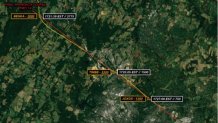The National Transportation Safety Board is shedding some light on what led up to a Nov. 27 plane crash in Gaithersburg, Maryland, that left a pilot and passenger dangling 100 feet above the ground for hours and caused a power outage impacting thousands.
The agency released a preliminary report Monday saying "dark night instrument meteorological conditions" — in this case, overcast skies with poor visibility — forced pilot Patrick Merkle to rely on instruments during flight, and that the plane was flying lower than the minimum altitude during its descent.
Merkle's licensing and the plane's inspections were up to date, and the pilot had more than 1,400 hours of flight experience, according to the NTSB report.
We're making it easier for you to find stories that matter with our new newsletter — The 4Front. Sign up here and get news that is important for you to your inbox.
The report said a post-crash inspection showed the engine, altimeter, propeller, fuel system and other mechanics worked as expected.
While returning from White Plains, New York, the single-engine Mooney M20J plane hit PEPCO power lines during the descent, then slammed into a power transmission tower near Goshen Road and Rothbury Drive about 5:40 p.m. the Sunday after Thanksgiving, NBC Washington reported.
Merkle was flying 225 to 500 feet below the minimum altitude as the plane approached Montgomery County Airpark, according to primary flight track information listed in the report.

The NTSB report says air traffic control advised Merkle to make a certain approach to Montgomery County Airpark, but he went a different route.
Local
Washington, D.C., Maryland and Virginia local news, events and information
“The pilot made a series of left and right turns, near course reversals, or continued established headings as the controller repeatedly requested that the pilot turn to a different heading,” the report said.
The NTSB says at one point during his descent, Merkle told air traffic controllers he entered the wrong waypoint name into his system.
The crash knocked out power for 85,000 customers for hours, PEPCO said.
Merkle and his passenger were trapped in the plane dangling from the tower while first responders carried out a complex, seven-hour operation to secure the plane, then rescue the pair. Both were seriously injured in the crash, the NTSB report said.
The NTSB’s findings align with what Merkle told a 911 dispatcher he spoke to while trapped in the aircraft.
“Totally a visibility issue. We were looking for the airport. I descended to the minimum altitude, and, uh, then, apparently, I got down a little bit lower than I should have,” Merkle said.
Dan Ronan, a licensed commercial pilot with training in accident investigation, said flying in fog is difficult even for the most experienced pilots.
“You have no visual reference. You can’t look outside because you’re in the clouds,” Ronan told News4.
Ronan said several things indicate that this pilot was having trouble.
“The best course of action would have been to go to another airport and sit it out, wait it out, and wait for the weather to get better,” Ronan said.
According to the NTSB report, another pilot approaching Montgomery County Airpark around the same time as Merkle requested a diversion to another airport due to the poor conditions in Gaithersburg.



